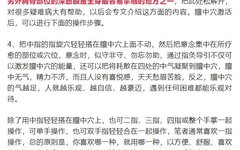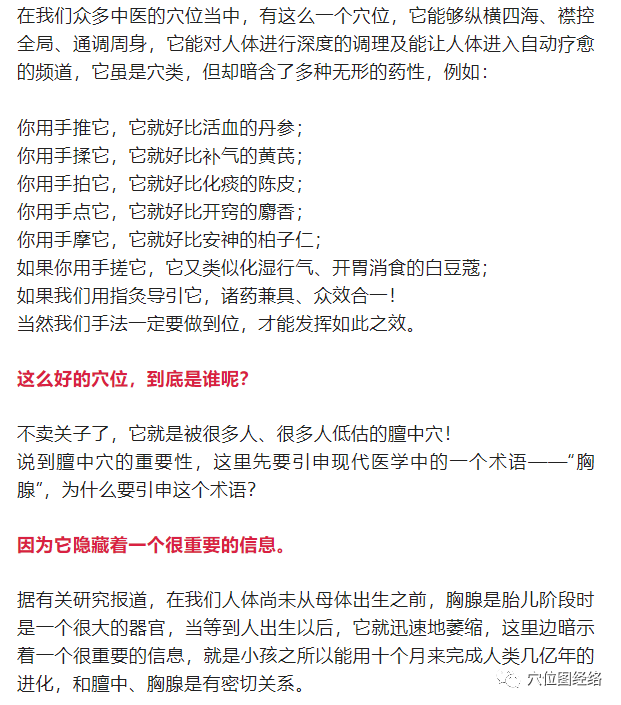
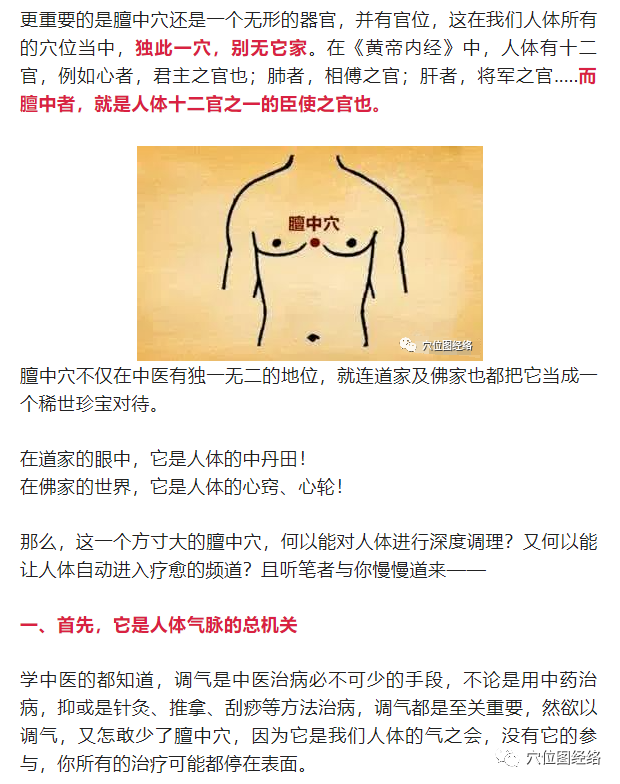
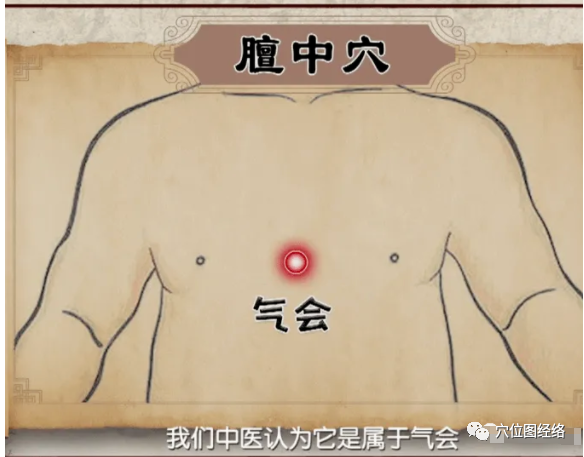
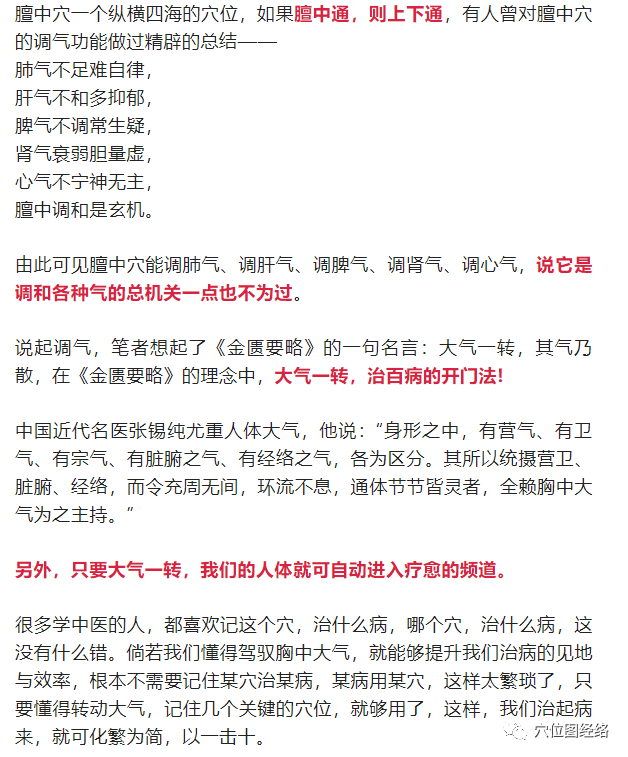
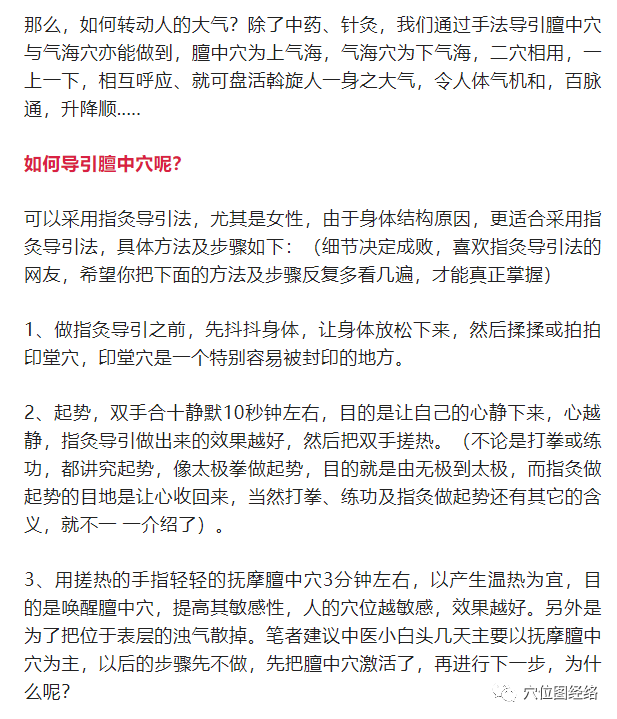
Because “the Shanzhong (Ren 17) must be activated before use,” this means that the Shanzhong point should not be used for tapping, massaging, or guiding until it is activated.
The acupuncture meridian point chart suggests that while tapping or massaging an unactivated point may initially have benefits, over time it can leave some potential side effects. In fact, many people use the Shanzhong point in their daily lives without activating it first, simply tapping, massaging, or guiding it with their palms.
When stroking the Shanzhong point, the lighter and slower the touch, the better. It should be done with love, as if caressing a newborn child—softly, gently, and slowly. It can even be done so lightly that it barely touches the skin, causing the hair on the skin to stand up. In summary, the lighter, slower, and softer the technique, the more it can awaken the potential energy of the Shanzhong point for our use. This gentle approach is akin to the principle of using less fire to create warmth.
From a multidimensional holographic perspective, the Shanzhong point corresponds to the Mingmen (Gate of Life) point, thus stroking the Shanzhong point can indirectly strengthen the body’s Mingmen fire. The importance of the Mingmen fire is well-known among TCM practitioners, so I will not elaborate further.
If you often feel stiffness in your back muscles or have a hunchback, you can massage the entire sternum, including the Shanzhong point, which can assist in improving the hunchback. This is an application of treating the root before the branch.
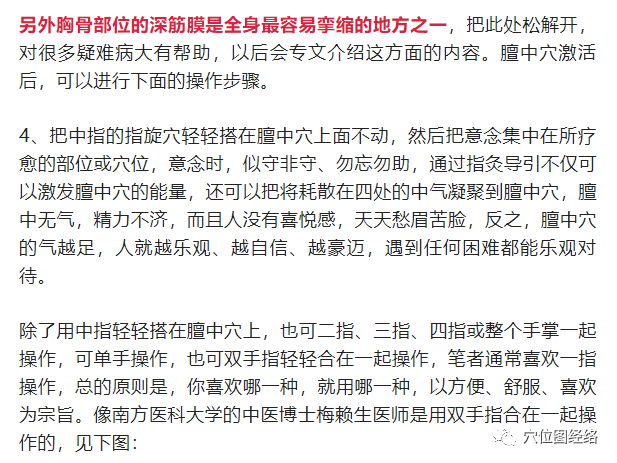
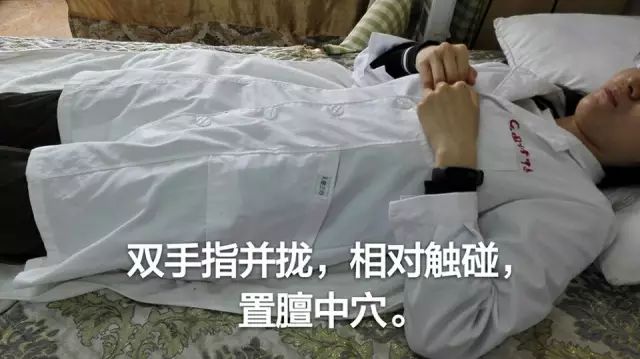
During the process of guiding the Shanzhong point, some individuals may experience a needling sensation at the Shanzhong point, as if undergoing an invisible acupuncture treatment, followed by a sensation of heat. Initially, the entire chest may feel warm, and soon the Ren Mai (Conception Vessel) will also feel the heat. At first, the warmth in the Ren Mai may be subtle, but with repeated practice, the sensation will become stronger, and the lower abdomen may also feel warm. Some may even feel the warmth radiating to the Huiyin (Perineum) point, creating a mobilizing sensation. Most people will hear gurgling sounds in their abdomen, which are normal responses of Qi and force waves.
Some individuals may also experience a dull pain in the stomach or lower abdomen, indicating a search for illness, suggesting that there may be hidden issues in these areas.
Others may feel a sense of emptiness, as if other parts of the body do not exist, with only a faint awareness remaining. This is also normal and should not cause fear or panic; it is a sensation similar to entering a meditative state.
Some may feel an urge to cry during the process, which is also normal, indicating the release of suppressed negative emotions.
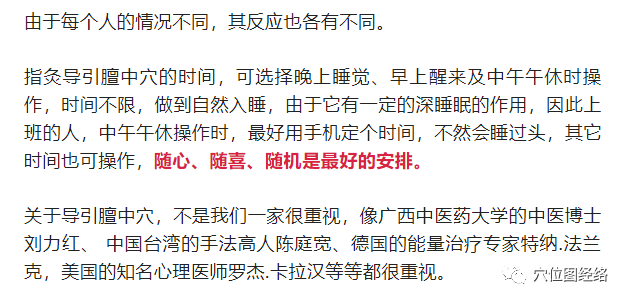
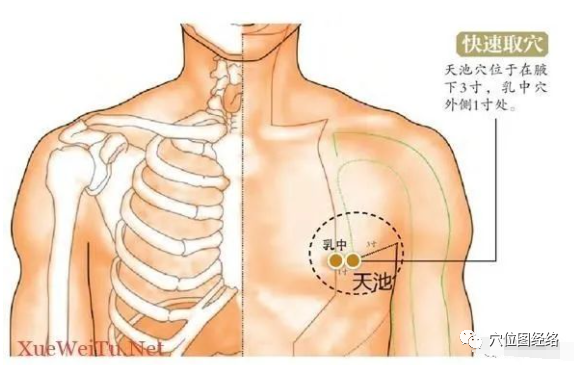
5. If after seven consecutive days of practice, there is no warmth in the chest or Ren Mai, it may indicate a serious blockage at the Shanzhong point. In this case, do not practice the Shanzhong point; instead, massage the Tianchi (Heavenly Pool, PC 1) or Zhongwan (Middle Cavity, Ren 12) points. Choose the one that is most painful; if both are painful, massage both. Once the pain diminishes, you can then guide the Shanzhong point.
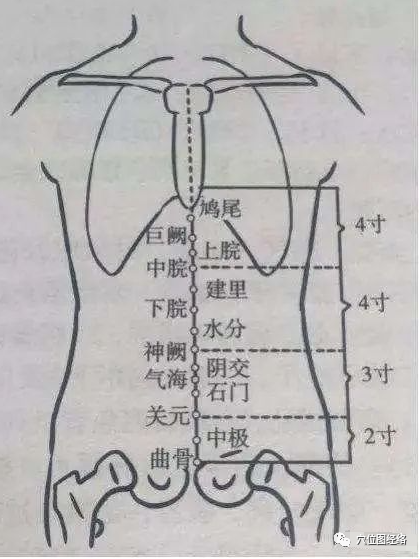
6. After the treatment, it is important to conclude the practice. If you do not conclude, the practice will be in vain. How to conclude? If you are lying down while practicing, after guiding the Shanzhong point, do not get up immediately. Place both hands on the Shenque (Spirit Gate, Ren 8) point and rest for 1-5 minutes. After getting up, shake your arms a few times, then rub the fingers used for the treatment to activate the Qi and blood in your arms and fingers, preventing stiffness. Finally, bring your hands together in a prayer position and remain silent for about 10 seconds.
7. Once you are proficient, you can also combine the Qihai (Sea of Qi, Ren 6) point in your practice for better results. The combination of these two points can invigorate the body’s Qi, allowing one to enter a self-healing state.
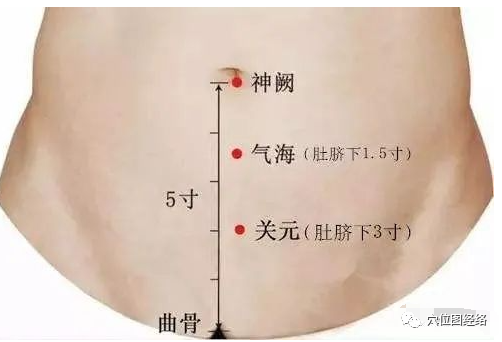
8. You can also choose other acupuncture points for guiding, but starting with the Shanzhong point is better. This establishes a foundation and stabilizes the axis. Once the axis is secured, you can address the surrounding areas more effectively, achieving better results with less effort and minimizing distracting reactions. Furthermore, starting with the mind allows for higher intentions, controlling the overall situation and reducing dimensional conflicts. When the mind is settled and the Qi flows smoothly, many diseases can heal spontaneously. TCM believes that all diseases begin as mental issues, then Qi issues, followed by blood issues, and finally physical issues. The Shanzhong point is crucial for regulating the mind and spirit, so starting with it can directly address the root cause of illness (mental issues are the true source of disease). More importantly, once the Shanzhong point is guided smoothly, our body will automatically enter the channel of “regulating the heart, “ as the heart governs the spirit. Additionally, starting with the Shanzhong point can enhance the body’s ability to renew Qi. Our body’s Qi needs constant renewal; otherwise, we become easily fatigued and prone to illness. Who facilitates this renewal? It primarily relies on the gathering and dispersing of Zong Qi (Ancestral Qi), which is concentrated at the Shanzhong point. If the Shanzhong point is not open, it will inevitably affect the capacity of Zong Qi.
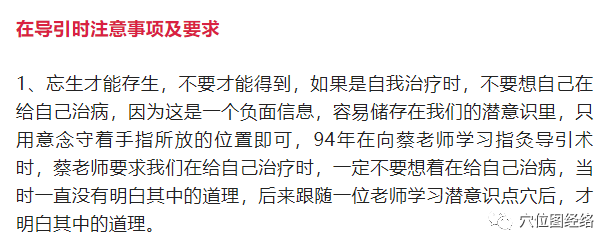
2. During the guiding technique, maintain a smile and keep the corners of your mouth raised at a 45-degree angle. Many instructors require a smile during practice, but why is this important? A significant number of people understand the concept but not the reasoning behind it. Today, I will briefly discuss its benefits.
Smiling and raising the corners of the mouth can activate the body’s positive energy switch, opening the joy switch for 60 trillion cells. Additionally, raising the mouth corners at a 45-degree angle can cleverly open the Shang Kunlun (Upper Kunlun, ST 6) point, which is prone to stagnation. All diseases are primarily related to Qi and blood; when Qi flows, there is no stagnation, and when it does not flow, stagnation occurs. New stagnation is small, but prolonged stagnation becomes significant. (Shang Kunlun refers to the Jiache point.)
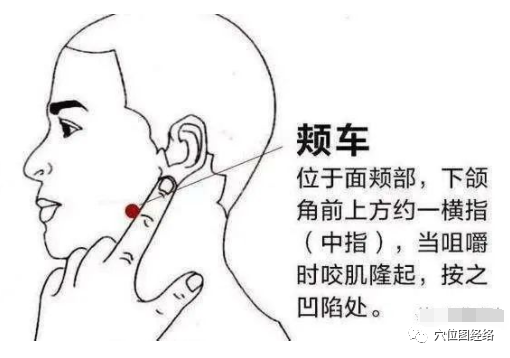
3. If you can combine inner vision with the treated area or acupuncture point, the effect will be even better.
4. Your intention and fingers should be unified, allowing your intention to reach the Qi.
5. The body should be relaxed; the more relaxed you are, the better you can stimulate Qi and blood, and the meridian system will enter an automatic adjustment state.
6. During the practice, keep your mind calm. When a person can truly calm down, just a gentle message to the body can trigger a series of significant Qi transformation reactions.
7. The Buddha said: “When the mind is focused, nothing is impossible.” During practice, be dedicated and do not think of other matters, nor think about treating the illness. Simply observe the area or point that needs healing quietly; with sincere practice, you will surely achieve results.
8. Do not pursue or focus on sensations such as heat, swelling, coolness, or numbness during the guiding technique, as this can distract and exhaust your energy. Allow sensations to come and go naturally.
9. When focusing your intention, do not forget or assist too much; do not hold on too tightly, but do not let go either.
II. Shanzhong Point – The Great Manager of Human Emotions
Both TCM and Western medicine agree that at least 70% of diseases in the human body are related to emotions. In TCM, diseases related to emotions are classified as emotional disorders. When treating illness, regardless of the method, if you neglect to adjust emotions, you will not achieve comprehensive and deep regulatory effects! To adjust emotions, the Shanzhong point is the first choice, as it is the great manager of human emotions.
In my early years, I learned a method called “internal organ unlocking.” Many have heard of the “eight and a half unlocking method,” but there is also an internal organ unlocking method. In this method, regardless of the disease being treated, the first step is to unlock the Zijin lock (Purple Gold Lock). (The Zijin lock in the eight and a half unlocking method shares the same name but has different meanings; in the internal organ unlocking method, the Zijin lock is at the Shanzhong point, which is also known as the Purple Gold City.)
Why is the Zijin lock unlocked first during internal organ unlocking?
Because unlocking the Zijin lock and clearing the Shanzhong point can bring joy to a person. The reason why the Shanzhong point can bring joy is explained in the “Huangdi Neijing (Yellow Emperor’s Classic of Medicine)”: “The Shanzhong is where joy and happiness emerge!” When a person opens their heart and mind, all diseases will lessen.
Everyone knows that treating illness requires adjusting the heart, but how do we adjust the heart?
Actually, making the patient happy and joyful is a way to adjust the heart. In clinical practice, if we can make the patient happy and joyful, it has significant implications for resolving diseases. Those engaged in traditional Chinese medicine know that as pathogenic factors penetrate deeper into the body, they become more severe and harder to treat. If we want to prevent pathogenic factors from penetrating deeper, making the patient “happy and joyful” is the primary condition. This principle is clearly stated by the ancient medical sage Zhang Zhongjing in the fourth clause of the “Taiyang (Sun) Chapter”: “If a person has a cold for one day and the pulse is quiet, it is not transmitted; if there is a desire to vomit, restlessness, and a rapid pulse, it is transmitted.” The phrase “desire to vomit, restlessness, and rapid pulse” indicates that if the mood is poor, it will lead to the disease penetrating inward. Zhang Zhongjing emphasized this point at the beginning, showing his deep understanding of the matter.
In clinical practice, we can observe that very few people with chronic diseases have a good mood. Why is that? The reason is simple: if a person has a lingering illness, can they genuinely feel happy?
Therefore, when a person is ill, if they can maintain a joyful heart, the disease will not penetrate inward; at most, it will remain on the surface. For superficial diseases, we can easily eliminate pathogenic factors using simple methods such as guasha, cupping, or gentle moxibustion.
From the perspective of ancient Chinese medicine, TCM does not focus on treating diseases but on treating people. How do we treat people? The most practical method is to start by changing a person’s mood.
Moreover, making people happy has the following effects:
1. Joy opens all meridians.
2. Joy brings the spirit, and illness retreats.
3. Joy represents Yang; once a person is joyful, true Yang energy will be generated within the body.
There is a famous saying in the West: “A clown entering town is worth more than a dozen doctors.” This vividly illustrates the importance of mood for health. Furthermore, in real life, we often find that many seriously ill patients do not die from their illness but from fear or depression. Those with depression or pessimism have not developed the positive energy of joy, which is related to the blockage of the Shanzhong point.
Many people are searching for the secret to healing, and making patients happy is indeed a healing secret!
In summary, when we regulate the body, if a person can calm down, relax, be joyful, and settle their mind, then the disease will improve by half!
III. Shanzhong Point – An Important Blind Spot for Human Diseases
The Shanzhong point can easily become blocked, leading to blockages throughout the body. It is a place where various negative emotions and turbid Qi tend to accumulate, and it is also a significant blind spot for diseases in the body. For example, rheumatism often manifests here; if this area is not treated, rheumatism is difficult to resolve completely. However, how many people consider this point?
The term “Shan” means flat! If this area is not open, one will lack joy, courage, and boldness! For modern people, regularly clearing the Shanzhong point is extremely important!
Due to various objective factors, the entire Shanzhong point and surrounding areas are often in a state of contraction. Over time, this leads to blockage at the Shanzhong point.
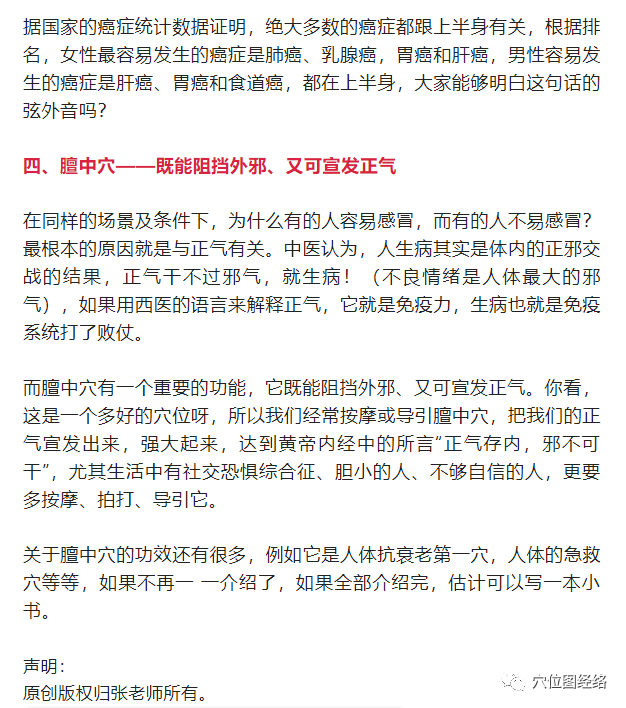
Like and support health together! Click below “business card” to follow us
Click below “business card” to follow us
Light it up so more people can see👇

